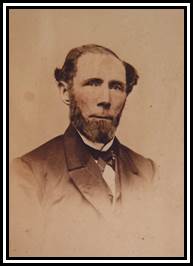James Witt Dougherty

Dougherty came to California first in 1849 with other forty-niners and opened a business in Sacramento. He returned briefly to Mississippi and moved to today’s beautiful Tri-Valley area in 1852 with his wife Elizabeth and children.
At one point he was the largest landowner in the Tri-Valley, with most of that land purchased from two Mexican rancheros — 10,000 acres from Jose Maria Amador and 7,000 acres from Francisco Alviso. Both men had problems with settlers living on their ranchos without acknowledging that the land was owned by them. Dougherty’s holdings went as far south as today’s Alviso Adobe and included today’s Tassajara and Dougherty Valleys.
He tackled the challenge of removing squatters by organizing an eviction crew. By this time, settlers had lived there for several years, built houses, planted orchards; many were armed and “were in no mood to be pushed around” according to one early source. With his ownership established, immense cattle herds were marked with the DG brand. In later years he worked on improved breeds of horses and raised Clydesdales and Normans.
The Doughertys lived in the large Amador adobe next to Almadilla Springs in Dublin until the 1861 earthquake destroyed it. Initially the Dublin crossroads (today’s San Ramon Road and I-580) was known as Amador’s, then became Dougherty’s Station. A post office with that name was established on February 15, 1860. Dougherty served as Alameda County Supervisor for the eastern part of the County (called Murray Township) in 1855, 1856, 1857 and 1859.
Evidently Dougherty had said at one point “There are so many Irish here, you might as well call it Dublin.” And indeed local leaders eventually named the crossroads Dublin. The Dougherty family was Scots-Irish and Protestant; they had immigrated to American around 1730.The pioneer Dublin Cemetery includes a prominent Dougherty family plot; he donated the western section of the cemetery as a non-sectarian burial area.
Dougherty Valley with cattle grazing, c. 1990
Amador’s rancho lands came to be called Dougherty Valley in Contra Costa County and were ranched for over 100 years. During that time, land was leased by several ranchers who grazed cattle and raised hay and grain crops. Bud Nielsen and his TN Cattle Company were the primary ranchers for 50 years until development began in 2004.
Six thousand acres of the Dougherty Valley were purchased by Shapell and Windemere Homes and, after some complex litigation was settled, 9-11,000 dwelling units, parks, schools, businesses and public buildings are planned for the area.
Contra Costa County and the City of San Ramon plan the valley’s development and it becomes part of the City.
Written by Beverly Lane, April 2022
From the Museum of the San Ramon Valley archives
Dougherty Valley photograph, Courtesy Shirley Nootbaar
James Witt Dougherty Bibliography
Amador, Jose Maria, Recollections, 1877, an oral history at the Bancroft Library, UC Berkeley
Banks, Peter M. An Investigation of the Cultural Resources within the Alamo Creek Planning Area, Contra Costa County, CA, April 15, 1981. (Quotes from the Banke brothers)
Bennett, Virginia Smith, Dublin Reflections and bits of valley history (Dublin: Dublin Historical Preservation Association), 1991
Brewer, William, Up and Down California in 1860-1864, Berkeley: UC Press, 1966
Contra Costa Gazette, July 18, 1868, Dougherty’s Station
Dotson, Irma M., San Ramon Branch of the Southern Pacific (Danville: Museum of the San Ramon Valley), 1991, pp. 5, 16, 56, 139-143.
Hoover, Mildred, et. al. Historic Spots in California (Stanford: Stanford University Press), 1948,1966. As revised by William N. Abeloe
Knave, Oakland Tribune, Nov. 28, 1965
Minnear, Steven, Dublin California, A Brief History, Charleston, S. C.: The History Press, 2018.
Museum of the San Ramon Valley archives (JWD Obituary, Dublin Cemetery information, family information donated to the museum, clippings)
New Historical Atlas of Alameda Co., California, Illustrated by Thompson & West and published in 1878. pp. 15, 16, 25, 26; 12, 28, 28 1/4
Stuart, Reginald R. and Grace D., Corridor Country, An Interpretive History of the Amador-Livermore Valley, Pleasanton: The Amador-Livermore Valley Historical Society, 1966.
Walnut Kernel, March 14, 1942 (may be another newspaper)
Wiedemann, Henry, History of Dougherty and San Ramon
Wood, Myron, History of Alameda County, 1883, p. 875
